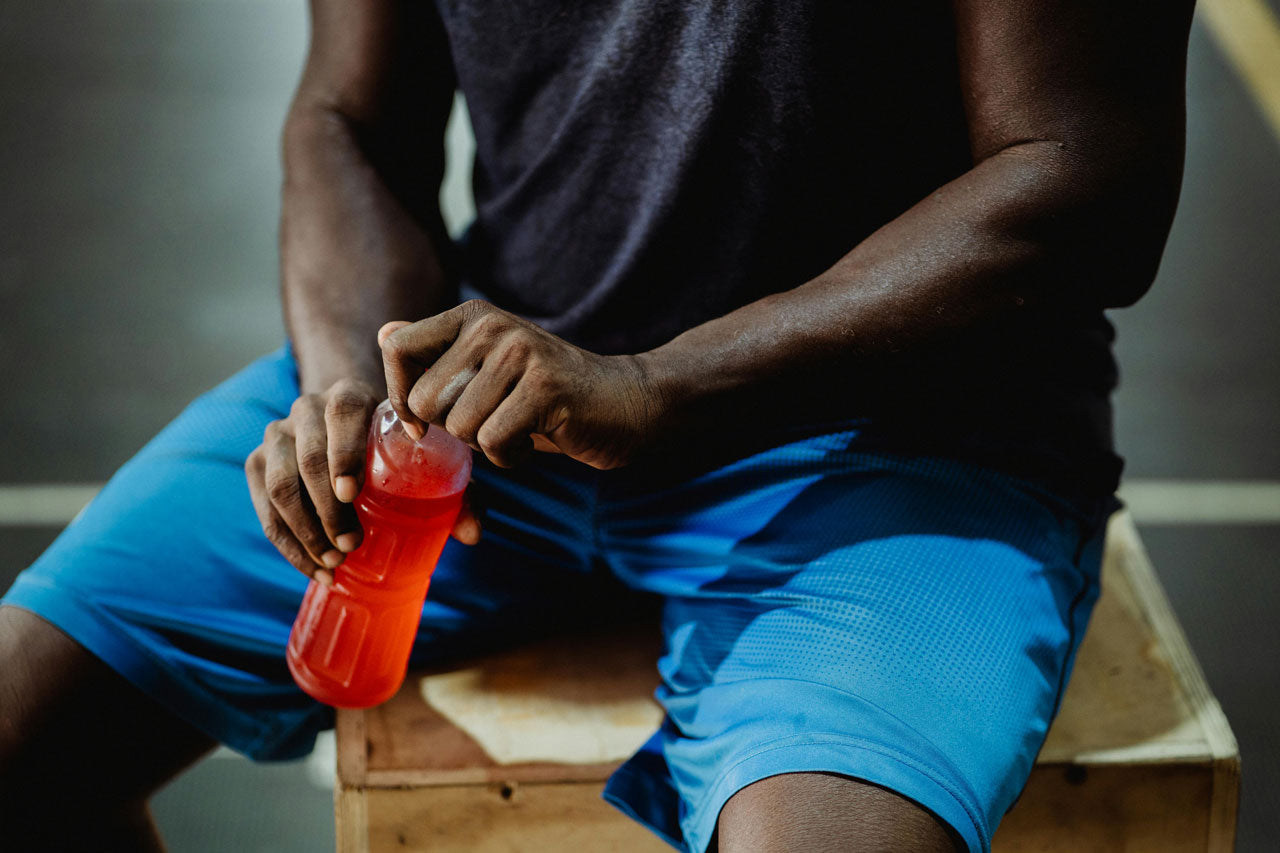We humans now dominate the Earth, but this wasn’t an obvious plot twist. Indeed, for most of history we were a marginal species that several times narrowly escaped extinction. But our trifold superpowers of Intelligence, Throwing, and Sweating, ultimately paid off. Just not in that order. Oh, and sports hydration drinks are a scam.
In the long history of life on Earth, our species appeared only recently, just a few hundred thousand years ago. And for most of our journey, we didn’t seem destined for glory. We were just one more primate trapped in Africa, living in scattered bands eking out a living hunting and gathering all the while trying to avoid predators. It was a precarious existence, occasionally flirting with extinction as at times our numbers shrank to mere thousands.
And yet today humans bestride the earth, outnumbering every other large animal species. Indeed, if we include our farm animals, we humans and our livestock account for a stunning 96% of Earth’s mammalian biomass.1 We have so far displaced other mammals that they are now just a rounding error in the Earth’s bookkeeping of life. Still more strikingly, it’s estimated that humans commandeer as much as 24% of the net primary production (NPP) generated by terrestrial plants each year.2
Our dominance wasn’t foreordained, and actually seems improbable given that humans are small, weak, and lack the usual hardware for hunting and defense such as large teeth and claws. Yes, we’re an intelligent animal, but the tale of how humans came to rule the Earth is much more interesting than simply “we outsmarted all those other creatures”. In fact, it was an unexpected trifecta of abilities, which we humans still possess, that allowed humans to become the Earth’s preeminent species.
It's the heat
Perhaps surprisingly, the ability that gave humans their initial edge wasn’t intelligence, which would come later, but rather sweating, which was of immediate importance because it provided an immediate advantage in the heat of the African savannah. While most mammals rely on panting and sparse sweat glands, humans gave up most of their fur and developed an extraordinary density of sweat glands—ten times that of our closest primate cousins. This transformation made us into “endurance specialists,” able to chase game over long distances across the savanna while other animals simply overheated and collapsed. Suddenly our prey’s advantage of speed was outweighed by our ability to simply stay cool.
From a distance
Persistence running will get you only so far, however. As a moderately sized animal that was weak and without defensive teeth or claws, humans were at extreme risk of predation. But a revolutionary tweak of body mechanics brought us a new ability, the ability to accurately and powerfully throw things. The shift occurred around two million years ago, and the throwing remains even today an ability unique to humans; our primate cousins throw as best they can, but their efforts appear comical to humans whose mastery of this skill is so complete. Humans can throw at over 100 mph, while the best chimps can muster is only 20 mph.3 This superpower was transformational; it not only provided for self-defense, but also turned us from opportunistic scavengers into formidable hunters. With stones and sharpened sticks hurled from a distance, we could safely bring down animals much larger than ourselves and so appropriate massive stores of protein and energy to fuel our ascendency.
Thinking things over
The whole while humans were experimenting with larger brains. But before larger brains were practical, humans had to work out how to hunt down the immense number of calories required to feed such a demanding piece of hardware: 20% of our total energy is used by our brain, which is just 2% of our body weight. By opening the door to a flood of calories, the twin physiologic adaptations of sweating and throwing set the stage for the emergence of larger brains and all that came in their wake: tools, fire, culture, and eventually agriculture and the ensuing technology that drives our modern civilization.

So that’s the story: a marginal monkey developed a prodigious ability to sweat and so out last prey when hunting, as well as the ability to throw rocks and spears to conclude the hunt when their prey finally dropped from exhaustion. More efficient hunting allowed larger brains and eventually tools, culture, and technology, a series of developments that happened at ever accelerating speed and left humans the preeminent species on Earth today. Bad at Sweating?
But lately we’re being told that we humans, the champion sweaters of the animal kingdom, are actually bad at sweating. Bad at sweating? How could we suddenly screw up something as simple as sweating, something we’ve excelled at for millions of years? Who’s saying that?
The massive sports drink industry, that’s who.
The Problem with Electrolyte Replacement Drinks
Oral replacement of depleted electrolytes has been a part of medical practice for almost 100 years, and glucose electrolyte mixtures had been popularized in the UK in the early 1900’s when drinks with names like Lucozade appeared.4
But it was Gatorade that was the breakout product. University of Florida coach Dwayne Douglas noticed that some players were losing as much as 18 pounds of sweat in a single workout. Seeking a solution, in 1966 he teamed up with Dr. Robert Cade, a nephrologist at UF’s College of Medicine, and the two came up with a mix of sugar and salt with a little lemon juice for flavor that was ultimately dubbed Gatorade. This formula was entirely made up, with no recourse to the long history of previous oral rehydration research. No, Gatorade’s formula was derived from taste testing. Later Gatorade’s marketing team would claim it was a “balanced electrolyte solution” but this too was false, because Gatorade is in fact hypertonic. Nevertheless, Gatorade’s claims that it was helpful in the extreme heat and workout intensity of Florida’s football culture caught on, and the drink soon became a sensation.5 (And it didn’t hurt that UF had a winning season that year.)
The real magic, however, came with the subtle elide from extreme workouts to every workout. This was an advertising redirect that marketers dream about, and it happened like this. When Gatorade was acquired by Quaker Oats in 1983 the marketing leadership cannily aligned Gatorade with the ongoing cultural shift in America toward health and fitness. They repositioned Gatorade as essential not just for athletes, but also for “fitness buffs, competitive team players, and people working physically demanding jobs.”6 This was a deliberate move to catch the rising tide of everyday Americans going to gyms and joining fitness classes. And it worked; sales jumped tenfold in the 1980’s. Unwilling to miss out on a new market, “Big Soda” (PepsiCo and Coca Cola) bought into the cash grab, buying up existing brands and establishing new ones, and by 2024 Gatorade and it’s like were selling over $30 billion worth of slightly salted sugar water every year and generating eye watering profits. Thirty billion dollars and 500 billion plastic bottles worth of fitness drinks, each year, year after year after year.
But It Was All A Lie
As we noted earlier, however, humans have actually been optimized over millions of years of evolution to sweat almost perfectly, to tolerate moderate dehydration easily, and for water as the ideal rehydration drink. Part of the body’s wisdom it that it minimizes the loss of electrolytes when sweating. Indeed, sodium losses in the sweat of people who work out regularly and are thus “desert adapted” is extremely low, about 0.3 grams/liter. Note that an average athlete sweats about 1 liter per hour, for a net loss of 0.3 grams of salt per hour. For comparison, the human body contains in total about 100 grams of sodium. So, in an hour an athlete loses a trivial amount of sodium, about 0.3% of the body’s sodium store, an amount that doesn’t affect the inner workings of the body at all. Fifteen potato chips will replace this loss, but really, no need to even think about salt: any meal will have more than enough sodium to put things back in perfect balance.
If sports hydration drinks are entirely unnecessary for even serious athletes, why are they so popular? Mostly it’s another triumph of marketing over science in which science has been in some measure complicit.7 Ads focusing on professional athletics are crafted to suggest that sports hydration drinks improve performance8, and showing elite athletes consuming brightly colored beverages on sidelines leads the audience to associate these drinks with peak performance. And it doesn’t stop at the gym: 60% of Americans now drink sports drinks whether exercising or not, thus creating an even bigger market. Now, even if you can’t be bothered to exercise, you can at least bask in the reflected glory of those who do exercise by simply buying a “sports” drink. As one marketer observed: “Drinking a sports drink is a way of consumers to convince themselves that they are looking after their bodies without having to break out into a sweat”.9
Unfortunately, the ruthless marketing of sports drinks is not a victimless crime. Thirty billion dollars spent and 500 billion plastic bottles worth of litter, each year, year after year after year, amount to a terrible toll based on marketing alone.
And there have been deaths.
In the 1970’s Gatorade paid for research that eventually led The American College of Sports Medicine (ACSM) to recommend that marathoners: “Drink as much as tolerable during exercise”10 The Gatorade Sports Science Institute (GSSI) aggressively promoted this message, including 2002 advertisement in New York Runner magazine claiming: "Research shows your body needs at least 40 oz. of fluid every hour (ie, 1200 ml per hour) or your performance could suffer".11
Unfortunately, many marathon runners who took this advice and ignored their natural thirst reflex developed serious electrolyte imbalances, primarily low serum sodium, a problem which could lead to brain swelling even be fatal. A paper in the New England Journal of Medicine12 meticulously documented that 13% of runners in the Boston Marathon had serious electrolyte imbalances in blood samples taken at the end of the race; several had critically low levels of sodium. And this problem was already well known: three years earlier in the 2002 Boston Marathon one runner, Cynthia Lucero, had died as a result of electrolyte imbalance brought on by following the “Drink as much as tolerable during exercise” mantra from Gatorade.
Mounting evidence of hyponatremia dangers eventually led Gatorade to quietly drop its “Drink as much as tolerable during exercise” messaging, but it wasn’t until 2015 that Gatorade-sponsored scientists began recommending the physiologically obvious (but far less profitable) message, "Drink to the sensation of thirst".
Unfortunately, marketing overruling science is not a new problem: think of the asbestos and tobacco industries exertions to mislead the public in the last century, or in this century of the opioid crisis created by Purdue Pharma’s misleading pitch of OxyContin to doctors and patients alike. These three schemes have killed tens of millions of Americans over the years.
Thankfully, sports drinks didn’t kill many people. Just our pocketbooks and our planet.
What’s to be done? Well, one can imagine a new ad campaign: With a voice over saying something like “Water, the hydration choice of long-distance champions for over 3 million years!” over a granny black and white video of humans running down an unsympathetic carnivore, say a hyena, in the African heat.
Unfortunately, it’s not clear who might fund such a campaign. So, for now, we’ll have to lobby for a saner, less market driven, approach to athletic hydration ourselves. Because sadly, water has no advocacy group.
But you can help spread the word. All we need for hydration is all we’ve ever needed for the last 3 million years. The simplest hydration drink of all is the one that we’ve all been optimized to drink: clear, bright, refreshing, cold, water.
1 Gee H. The Decline and Fall of the Human Empire: Why our species is on the edge of extinction. London: Picador; 2025.
2 Haberl H, Erb K-H, Krausmann F, Gaube V, Bondeau A, Plutzar C, Gingrich S, Lucht W, Fischer-Kowalski M. Quantifying and mapping the human appropriation of net primary production in earth’s terrestrial ecosystems. Proc Natl Acad Sci U S A. 2007;104(31):12942-7.
3 Why chimps don’t play baseball [Internet]. YouTube; [cited 2025 Aug 20]. Available from: https://www.youtube.com/watch?v=Jq6dCFCMGq4
4 Striepe B. Who invented sports drinks? [Internet]. HowStuffWorks; [cited 2025 Aug 20]. Available from: https://science.howstuffworks.com/innovation/everyday-innovations/who-invented-sports-drinks.htm
5 Cade R, Spooner G, Schlein E, Pickering M, Dean R. Effect of fluid, electrolyte, and glucose replacement during exercise on performance, body temperature, rate of sweat loss, and compositional changes of extracellular fluid. J Sports Med Phys Fitness. 1972 Sep;12(3):150-6. PMID: 4669055.
6 Gatorade Company. In: Encyclopedia of Business and Finance [Internet]. [cited 2025 Aug 20]. Available from: https://www.encyclopedia.com/books/politics-and-business-magazines/gatorade-company
7,9 Cohen D. The truth about sports drinks. BMJ. 2012 Jul 18;345:e4737. doi:10.1136/bmj.e4737.
8 Bragg MA, Roberto CA, Harris JL, Brownell KD, Elbel B. Marketing food and beverages to youth through sports. J Adolesc Health. 2018 Jan;62(1):5-13. doi:10.1016/j.jadohealth.2017.06.016. Epub 2017 Oct 27. PMID: 29111226; PMCID: PMC6634297.
10,11 Noakes TD, Speedy DB. Lobbyists for the sports drink industry: an example of the rise of “contrarianism” in modern scientific debate. Br J Sports Med. 2007 Feb;41(2):107-9. PMCID: PMC2658915.
12 Almond CS, Shin AY, Fortescue EB, Mannix RC, Wypij D, Binstadt BA, Duncan CN, Olson DP, Salerno AE, Newburger JW, Greenes DS. Hyponatremia among runners in the Boston Marathon. N Engl J Med. 2005 Apr 14;352(15):1550-6. doi:10.1056/NEJMoa043901. PMID: 15829535.





Leave a comment
All comments are moderated before being published.
This site is protected by hCaptcha and the hCaptcha Privacy Policy and Terms of Service apply.